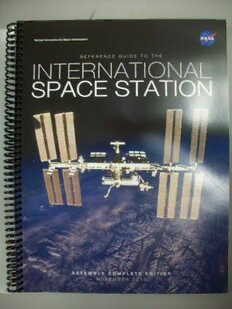
Reference Guide to the International Space Station PDF
Preview Reference Guide to the International Space Station
National Aeronautics and Space Administration R E F E R E N C E G U I D E T O T H E INTERNATIONAL SPACE STATION A S S E M B L Y C O M P L E T E E D I T I O N N O V E M B E R 2 0 1 0 ISS 2009 Robert J. Collier Trophy winner The Collier Trophy is awarded annually “for the greatest achievement in aeronautics or astronautics in America, with respect to improving the performance, efficiency, and safety of air or space vehicles, the value of which has been thoroughly demonstrated by actual use during the preceding year.” Library of Congress Cataloging-in-Publication Data Reference guide to the International Space Station. -- Assembly complete ed. p. cm. Rev. ed. of the NASA document: Reference guide to the International Space Station. August 2006. “November 2010.” “NP-2010-09-682-HQ.” ISBN 0-16-086517-4 1. International Space Station. 2. Space stations--International cooperation. 3. Manned space flight. I. United States. National Aeronautics and Space Administration. TL797.R44 2010 629.44’2--dc22 2010040473 R E F E R E N C E G U I D E T O T H E INTERNATIONAL SPACE STATION A S S E M B L Y C O M P L E T E E D I T I O N N O V E M B E R 2 0 1 0 National Aeronautics and Space Administration Washington, DC NP-2010-09-682-HQ REFERENCE GUIDE TO THE ISS CONTENTS 2 REFERENCE GUIDE TO THE ISS CONTENTS 3 What It Does 7 Research Guide 21 How It’s Put Together 45 How It’s Supported 63 How the Crew Lives 79 How It Works 85 How It’s Built 97 Missions 111 s Appendix 129 t n e t n o c Shown in the foreground, a telephoto view of the U.S. Lab. Clockwise from the left, the Pressurized Mating Adapter, the Space Station Remote Manipulator System, Soyuz, and Pirs. In the background, the U.S. Airlock. REFERENCE GUIDE TO THE ISS 4 REFERENCE GUIDE TO THE ISS A LETTER FROM THE ASSOCIATE ADMINISTRATOR 5 SPACE OPERATIONS MISSION DIRECTORATE Assembly of the International Space Station (ISS) is a remarkable achievement. Since November 2, 2000, humankind has maintained a continuous presence in space. Over this timespan, the ISS International Partnership has flourished. We have learned much about construction and about how humans and spacecraft systems function on orbit. But there is much more to do and learn, and this voyage of research and discovery is just beginning. We now shift our focus from ISS assembly to full ISS utilization for scientific research, technology development, exploration, commerce, and education. We need to approach this next research phase with the same dedication, zeal, and innovation that we used to assemble the ISS. United States research concentrates on biology, human research, physical science and materials, Earth and space science, and technology for exploration beyond low-Earth orbit. As a national laboratory, the ISS is beginning to provide new opportunities for other agencies, academia, and commercial and other partners to pursue novel avenues of research and development, and to promote science, technology, engineering, and math education. We cannot now foresee all that may be uncovered on this voyage, but we look forward to the voyage and returning knowledge to extend the human presence beyond and improve life here on Earth. —William H. Gerstenmaier Associate Administrator NASA Space Operations Mission Directorate REFERENCE GUIDE TO THE ISS 6 REFERENCE GUIDE TO THE ISS WHAT IT DOES 7 The International Space Station (ISS) is the unique blend of unified and s diversified goals among the world’s space agencies that will lead to improvements in life on Earth for all people of all nations. While the e various space agency partners may emphasize different aspects of o research to achieve their goals in the use of the ISS, they are unified in several important overarching goals. d All of the agencies recognize the importance of leveraging the ISS as an education platform to encourage and motivate today’s youth to pursue careers in math, science, engineering, and technology (STEM): educating t the children of today to be the leaders and space explorers of tomorrow. i Advancing our knowledge in the areas of human physiology, t biology, and material and physical sciences and translating that a knowledge to health, socioeconomic, and environmental benefits on Earth is another common goal of the agencies: returning the knowledge h gained in space research for the benefit of society. Finally, all the agencies are unified in their goals to apply knowledge w gained through ISS research in human physiology, radiation, materials science, engineering, biology, fluid physics, and technology: enabling future space exploration missions. REFERENCE GUIDE TO THE ISS WHAT IT DOES 8
